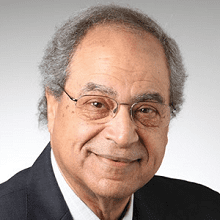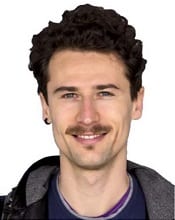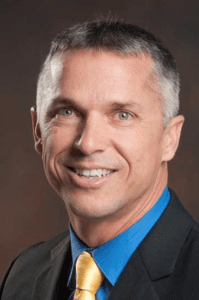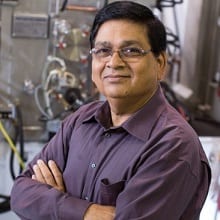Day 1 – Wednesday October 16, 2019
Prof. Roshdy Hafez
Carleton University
Topic: 5G Powerful Engine for the Connected Society
Abstract: Some aspects of 5G are currently being deployed. Soon, there will be wide deployment worldwide. 5G advances wireless communications along three important directions: (1) much faster transmission rate, (2) support for ultra-reliable communications and (3) introducing network slicing. This presentation considers 5G advances from the applications viewpoint. If one wants to summarize 5G in one word, it would be “flexibility”. 5G promises to cover a wide range of data rates from the very low data rate associated with slow data collection over wide areas (e.g. some form of IoT) to the extremely high data rate associated with venues crowded with dense users equipped with advanced devices capable of streaming HD videos and other data intensive applications. It also promises to support high precision and low latency applications (e.g. connected vehicles) and Machine Type communications. The array of known potential applications is very long. The availability of extreme high speed, flexible context-aware networking and ultra-low latency communications would sure trigger the imagination of many entrepreneurs to come up with new and innovative applications. For sure, the next few years, 5G will provide significant boost of the economy, create many new jobs and opportunities. It’s powerful platform for total connectivity and data-driven economy. In this talk, 5G is discussed as new and powerful enabling technology or more precisely a set of new technologies. One of the aim of the talk is to describe the inherent flexibility in 5G and how this flexibility and powerful techniques will enable a new and innovative applications with profound impact on our lives. For example, the core network is being changed considerably through virtualization, virtual machine implementation and network slicing. This will allow different applications to share hardware and infrastructure in a flexible and efficient way. Networks could be built up and teared down at the virtualization level and individual networks could be designed and mapped on the existing infrastructure to fit the specific requirement of the application they serve without compromising quality by catering to average user’s requirements. Different levels of data centers and clouds with different proximities to network cores address latency requirements. Another aspect is the various form of spectrum aggregation toolboxes and algorithms as well as integrating WiFi and cellular capabilities to provide a very dynamic use of the spectrum and allow the use of a very large pieces of spectrum stitched together to support extremely high data rate where and when needed. 5G is still evolving. It will meet our current communications need, making it better and more powerful but more importantly, it is about to enable many new applications that will support an emerging digital economy.
Biography: Roshdy H. M. Hafez obtained the Ph.D. in Electrical Engineering, from Carleton University, Ottawa, Canada. He joined the Department of Systems and Computer Engineering, Carleton University as an assistant professor, and he is now a full professor. He served as a Department chair, from 2013-2015. Dr. Hafez has many years’ experience in the areas of Wireless communications, RF and spectrum engineering, integrated wireless/fiber communications and public safety. He supervised to completion 15 PhD and 51 Master research theses, published more than 70 technical papers almost all on wireless, lectured extensively in wireless and related areas. In particular, for many years he offered short professional on different to leading telecom companies and government departments. His current research focuses on learning from data as it applies to wireless networks and applications, broadband wireless networking, 4G/5G, wireless over fiber and sensor networks. He acts as a consultant to Ericsson, Nokia, RIM, General Dynamics, Industry Canada, Nortel and many other telecommunications companies. Dr. Hafez was actively involved and lead projects in federal and provincial centers of excellence and gave several tutorials in international conferences and taught many short courses to the industry.
Dr. Marco Mezzavilla
NYU, Research Scientist
Topic: Public Safety Communications above 6 GHz: Challenges and Opportunities
Abstract: Advanced public safety communication (PSC) services call for fast, reliable and low-latency communication technologies, capable of supporting diverse communication modes (aerial, unmanned, vehicular, and peer-to-peer), fast channel dynamics, and ad hoc or mesh structures. For this reason, PSC has been identified as one of the key potential uses cases for the next generation of communication systems, the so-called 5G. In this scenario, the millimeter wave (mmWave) bands and other frequencies above 6 GHz are particularly interesting, since they are largely untapped and offer vastly more spectrum than current cellular allocations in the highly congested bands below 6 GHz, thus enabling orders of magnitude greater data rates and reduced latency. For example, new PSC networks in the mmWave bands could support high-definition video, virtual reality, and other broadband data to large numbers of first responders. Surveillance drones or ambulances could also be provided high-speed connectivity along with machine-type communication for remotely controlled robotic devices entering dangerous areas. However, the way towards this ambitious goal is hindered by a number of open research challenges. In this talk, after a brief introduction to PSC services and requirements, we illustrate the potential of the frequencies above 6 GHz for PSC and discuss the open problems that need to be solved in order to pave this way. Finally, we describe the main components of a test platform for mmWave systems that is functional to the study of such complex scenarios and that we plan to develop as an invaluable tool for realizing mmWave PSC networks.
Biography: Marco Mezzavilla is a Research Scientist at NYU Tandon School of Engineering, where he leads various mmWave-related research projects, mainly focusing on 5G PHY/MAC design. He received the B.Sc. (2007) and the M.Sc. (2010) in Telecommunications Engineering from the University of Padova (Italy), and the Ph.D. (2013) in Information Engineering from the same university. He held visiting research positions at the NEC Network Laboratories in Heidelberg (Germany, 2009), at the Telematics Department at Polytechnic University of Catalonia (UPC) in Barcelona (Spain, 2010) and at Qualcomm Research in San Diego (USA, 2012). He has authored and co-authored multiple papers in conferences, journals and some patent applications. He is serving as reviewer for many IEEE and ACM conferences, journals and magazines. His research interests include design and validation of communication protocols and applications to Fourth-generation (4G) broadband wireless technologies, millimeter wave communications for 5G networks, multimedia traffic optimization, radio resource management, spectrum sharing, convex optimization, cognitive networks and experimental analysis.
Day 2 – Tuesday October 17, 2019
Prof. Mason Peck
Director of Graduate Studies, Aerospace Engineering, Cornell University
Topic: Autonomous Gram-Scale Spacecraft: Flight Experiments and Future Architectures
Abstract: Gram-scale spacecraft are known as chipsats. Dr. Peck’s lab at Cornell University is the first to design, build, and operate such tiny satellites. We expect this research to have a broad impact, democratizing access to space for science, exploration, and commercial applications. This research has also been central to the Breakthrough Starshot mission, a twenty-year engineering project to send a small spacecraft to Alpha Centauri, over 4 light years from Earth. The talk will assess some fundamental engineering-research challenges for this application and for more near-term missions, including big-data Earth science and planetary exploration.
Biography: Dr. Peck is an Associate Professor in Mechanical and Aerospace Engineering at Cornell University and the Director of Cornell’s Space Systems Design Studio. His research interests include space-systems architecture and satellite dynamics and control. From late 2011 through early 2014 he served as NASA’s Chief Technologist in Washington, DC. In that role, he acted as the agency’s chief strategist for technology investment and prioritization and advocate for innovation in aeronautics and space technology. His lab focuses on fundamental research in space technology that can be advanced through flight experiments. Examples include water-propelled lunar spacecraft, magnetically docked CubeSats, and Kicksat, a crowd-funded technology demonstrator for satellites-on-a-chip. His lab has flown on average one spaceflight experiment a year since 2011 and plans to launch three more spacecraft by 2019. More information on this research is available at http://www.spacecraftresearch.com and http://www.spacecraftlab.com.
Dr. Rick Schwerdtfeger
National Science Foundation, SBIR/STTR Program Manager
Topic: Non-dilutive Funding Opportunities for Deep Technology Companies from the National Science Foundation
Abstract: The Small Business Innovation Research (SBIR) Program operates like a national venture fund, investing roughly $2.5 B annually in small businesses disrupting global industries. The National Science Foundation (NSF) is at the cutting edge of this effort, funding nascent ventures with so-called “deep technologies”, transforming scientific discoveries into commercial impact. This presentation will describe the economic and strategic importance of this activity, NSF’s funding philosophy, and specific information for inventors in university projects and garage squads creating the next moonshot opportunities. America’s Seed Fund powered by the National Science Foundation (NSF) awards more than $200 million annually to startups and small businesses, transforming scientific discovery into products and services with commercial and societal impact. Startups working across virtually every discipline of science and technology can receive up to $1.5 million in non-dilutive funds to support research and development (R&D), helping de-risk technology for commercial success. America’s Seed Fund is congressionally mandated through the Small Business Innovation Research (SBIR) program. The NSF is an independent federal agency with a budget of about $8.1 billion that supports fundamental research and education across all fields of science and engineering. For more information, visit seedfund.nsf.gov.
Biography: C. Richard “Rick” Schwerdtfeger joined the National Science Foundation (NSF) in August 2016 as a Program Director for the Small Business Innovation Research (SBIR) and Small Business Technology Transfer (STTR) programs, providing $200 M annually to roughly 400 small businesses. Rick oversees a portfolio of approximately 110 small businesses with game-changing technologies across instrumentation and hardware, photonics, internet-of-things and space. Prior to joining NSF, Rick was the CTO and co-founder of the Advanced Renewable Energy Company, a clean-tech and semiconductor equipment company, where he led the technology development and customer deployment of nearly $200 M of equipment in the first four years. Additionally, he was the COO of Pica Solar, a DOE-funded solar cell technologies startup. Rick is an advisory board member of ClearCove Systems, a wastewater and renewable energy company. Rick has able been a Senior Project Scientist at the non-profit Edison Materials Technology Center, a Senior R&D Scientist at Saint Gobain, and the Crystal Growth Group leader at Alpha Spectra. He started his career as a Staff Scientist conducting solar energy research at the National Renewable Energy Laboratory. Rick has grown some of the largest sapphire, calcium fluoride, sodium iodide, and copper indium diselenide crystals in the world, which have been used to lower costs of technology for energy, lighting, radiation detection and other industrial and photonic applications. Rick has spent his career taking the “art” out of science, and replacing it with good engineering, experimentation and automation to solve challenging problems in the renewable energy, clean water, smart grid and high-tech world. Rick holds a Ph.D. in Materials Science from the Colorado School of Mines, an M.S. in Applied Physics from Pittsburg State University, and a B.S. in Physics and Science Education from the University of Dubuque.
Mr. Giorgio Magistrati
ESA ESTEC Exploration Preparation, Research and Technology Team Leader
Topic: Wireless in Space as seen by ESA and WiSEE 2020 Invitation
Abstract: WiSEE 2020 the 8th Conference on Wireless for Space and Extreme Environments will take place in Vicenza from the 12th to the 14th of October 2020. Information about the programme, the logistics and the venue will be provided.
The presentation will continue presenting the activities started or planned by ESA related to wireless technologies for Space.
Wireless technologies and applications have solidly anchored themselves in our daily life were they have also reached factories and automation processes around the world. In many cases they present an ideal solution for applications where the communication harness is hindering the system’s simplicity and maintainability, or where enabling remote monitoring/housekeeping increases the efficiency or the safety of the processes.
These technologies have their place in on-board or on-ground space applications. But for most of these applications, the required levels of reliability, robustness and determinism is currently beyond most commercially available wireless technologies. In their current state, most wireless technologies are in no position to play a central command & control role in space applications as they currently compete with extremely reliable wired busses (e.g. CAN, SpaceWire, Mil-bus- 1553b) operating within real-time constraints. But the industry have already started to use them for less critical applications like on-board sensing, ground testing, remote health monitoring, etc. To be widely adopted, wireless technologies must evolve to become deterministic, highly reliable, more robust and suitable for real-time applications.
Additionally adoption of wireless networks can allow easier ways to implement single-point failure free architectures. If redundancies are implemented and considering scenarios where the various nodes are separately powered (e.g. by means of batteries), in the case a node fails the impact on the overall functionality are minimised due to the fact a physical isolation among the elements of a wireless network exists.
High baud rates can also be achieved with proper topology and well planned time schedule and prioritisation.
Biography: Giorgio Magistrati has studied at the Politecnico of Milan where he graduated in Nuclear Engineering with a specialization in Electronics in 1989. He has worked for 8 years at LABEN (Italy, now Thales Alenia Space) as Hardware Designer for architectural & detailed design of Front End and Readout Systems for Nuclear Physics Experiments. In 1998 he has joined Carlo Gavazzi Space spa ( now OHB-I) as avionics system engineer. He has been avionics responsible for several space projects (Payload and Computer units on satellites and ISS) . In 2009 he has joined ESA-ESTEC as Head of On Board Computers and Data Handling Section in the Data Systems Division of ESA Technical Directorate managing support and R&D activities related to Data Handling. Since 1st May of 2019 he is the leader of the Exploration Preparation Research and Technology (ExPeRT) Team in the Human and Robotic Exploration Directorate of ESA.
Day 3 – Friday October 18, 2019
Dr. Prakash Patnaik
Principal Research Scientist & Program Leader, Defence Technologies & Sustainment, NRC Aerospace, Ottawa
Topic: Sensors in Aerospace Extreme Environment
Abstract: Extreme environments can threaten aircraft operations whether for military or civilian use or manned/unmanned operations. The range of extreme environments can be wide, and the major challenge of operation is not only able to survive such extreme environments but also to use these as a tactical advantage over adversaries and to own the extreme environments as well.
This keynote will address a challenge list associated with these specific aerospace extreme operational environments include: 1). Degraded visual environment (DVE) of recirculating dust, sand, snow and volcanic ash; 2) In-flight icing encounters presenting a major hazard to safe and efficient operations of both manned and unmanned aircraft; 3). Atmospheric turbulence, gusts and excessive loads (UAV ops); 4) Weather limitations when operating in terrestrial and maritime low altitude environments; 5). Wind limitations for the launch and recovery of small unmanned aircraft, both terrestrial and maritime environments; 6) Precipitation and icing for mid to high altitude operations in tropical convergence areas.
Introductions will be made to the impact of these extreme environments on air vehicle operations, including but not limited to aircraft engines, dynamic system components, and then the role of the sensors in these extreme environments. The mission is to identify candidate technologies that enable aircraft to operate in, and exploit a much wider range of extreme operating environments encountered in current and future missions. There is also a requirement to understand and identify capability gaps and challenges to ensure that candidate technologies are appropriately focused.
Biography: Dr. Patnaik received his B.Eng.(Hons) degree in India followed by a Masters and Ph.D. in Materials Science & Engineering from McMaster University in Canada in and had an impressive start to his career as a NSERC Visiting Fellow Research Scientist to the NRC’s National Aeronautical Establishment in 1984. He worked for internationally recognized defence companies such as Hawker Siddeley Canada and the Magellan Aerospace Corporation as a Senior Engineering/R&D Manager (1986-2001) prior to moving to NRC in 2002. In January 2002, Dr. Prakash Patnaik was appointed to NRC’s Institute of Aerospace Research as the Group Leader/Senior Research Officer of Metallic & Ceramic Materials in the Structures, Materials and Propulsion Laboratory. His contributions to Materials Science & Engineering and technologies related to aerospace sustainment and advanced manufacturing in the aerospace domain has been outstanding as reflected by his interaction with aerospace industry, government laboratories (NRC, NRCan and DND-DRDC) and the academia nationally and internationally. His technical expertise includes, Research & Development in and Advanced Engineering Materials & Structures with applications into Aerospace and Space Vehicles for Civil and Military including Advanced Manufacturing(3-D Printing), Gas Turbine Materials Technologies, Prognostics & Health management of Gas Turbines, Computational Materials Modeling from First Principles, Gas Turbine Lifing Methodologies, Surface Protection of Components from Degradation, Development of Sensing Methods for Strain, Temperature and Corrosion, Airworthiness Certification of components and Integrated Vehicle Health Management(IVHM) of Air Vehicles including sensors for extreme environments.
He became Principal Research Officer (the highest scientific rank at NRC) in 2005 and then in 2006 appointed as the Director of the Structures & Materials Performance Laboratory of the Institute. From 2006, he was given the leadership to lead the Air Defence S&T work at NRC and had the role of NRC Chief Scientist for DND/DRDC which he maintains till today. In 2012, he was appointed as the Leader of NRC’s Air Defence Systems Program (ADS) and working with DND, the RCAF and DRDC generated nearly $60M revenue (till the end of FY18) in the program and delivered research and technology outcomes in line with the ADS Program’s value proposition. Dr. Patnaik’s research engagement and contributions to private and public sector in Canada has led him to receive numerous recognitions and awards of which the ASM Fellow, Research Fellow Pratt Whitney Canada and Fellow of the Canadian Academy of Engineering are worthwhile to note. He has nearly 150 research publications in the open domain and has been instrumental in setting of the First Aerospace Materials Conference in Canada since 2002 (every two years) and acts as the Technical Editor. He was selected by CASI (Canadian Aeronautics and Space institute) in 2009 as the First Visiting lecturer to promote R&D between academia-industry and the research laboratories in Canada
Dr. Patnaik is a member of many international scientific organizations and committees and has earned many awards and recognitions in between 1978 till 2018. He is a member of the NATO Science and Technology Organization (STO) and a former Chair of the NATO-STO Technical Committee on Mechanical Systems and Materials for the Applied Vehicle Technology panel and recently elected to be the Vice-Chair of the NATO-AVT S&T Strategic Committee. In this capacity, he has developed and many S&T initiatives for collaboration at NATO on behalf of DND, NRC and the Canadian Defence industry. In December 2018, he received the NATO-AVT Panel Excellence Award for his outstanding contributions to the NATO S&T program of work in the Applied Vehicle Technology Panel.
He has recently been appointed by the Department of National Defence –DRDC as the Technical Advisor in Defence Materials & Defence Aerospace (Five Eyes TTCP Defence S&T Collaboration) as well. He also serves in the USAF-DND-DRDC Air Senior National Representative (ASNR) Board as a technical advisor from NRC. On the academic side, he has been adjunct professors at UBC, Carleton University and a Professor of Eminence at the Jain University in India. He has completed serving the UBC advisory board in Materials Engineering and currently serving in the industrial advisory board of the Carleton University Mechanical & Aero as well as an advisory board member of the Defence & Security Science at McMaster University in Canada. As a Fellow of the American Society for Materials (ASM) International in the USA, he was selected to give topical lectures in India & Canada in early 2000 to promote research collaboration between these three nations. A number of these appointments have been NRC First and/or Canada First.






